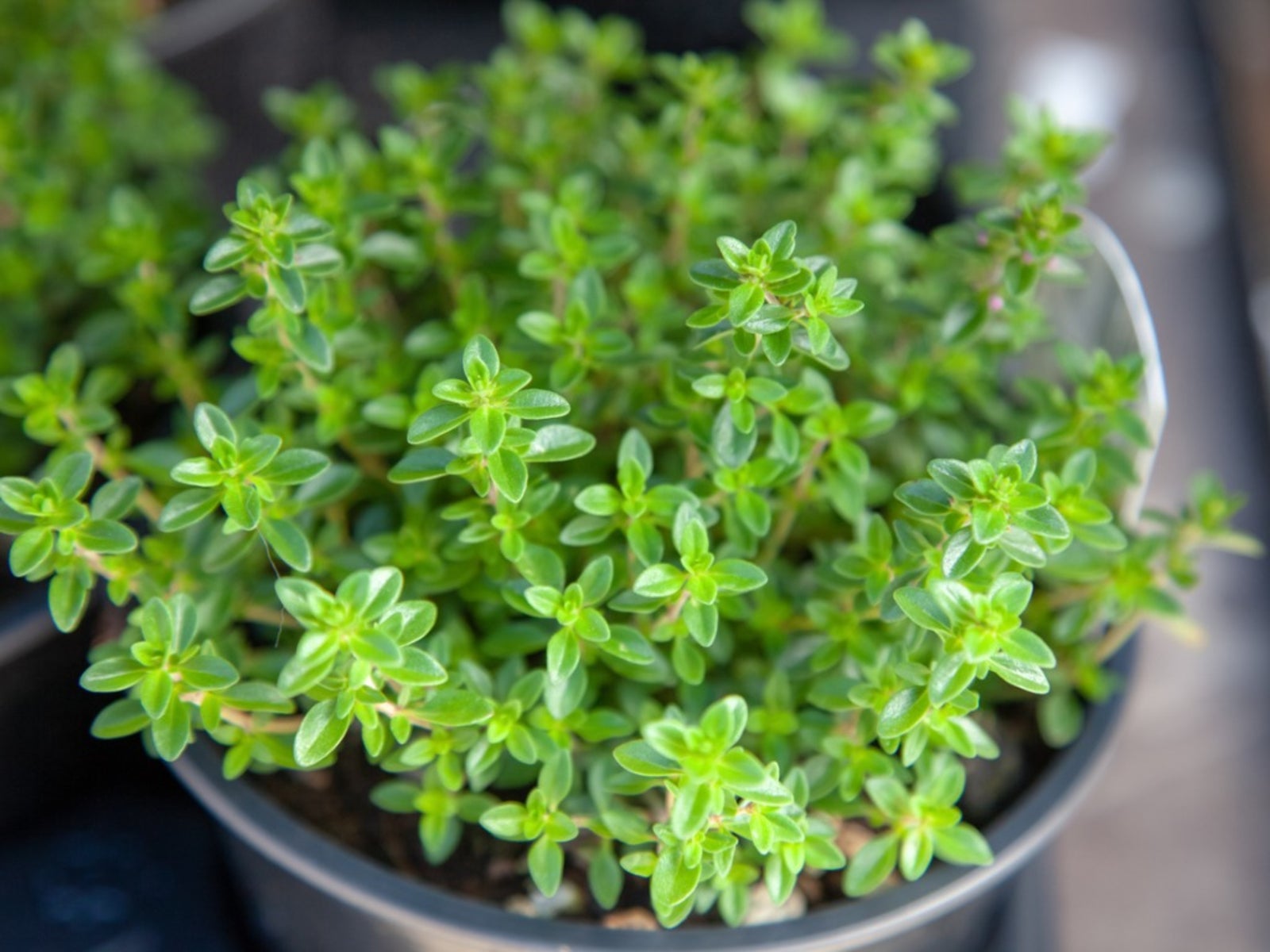Thyme, a fragrant and versatile herb, has been cherished for centuries for its culinary, medicinal, and decorative uses. Known for its earthy aroma and robust flavor, thyme is a staple in kitchens and gardens worldwide. But can it thrive indoors? The answer is a resounding yes!
Growing thyme indoors offers countless benefits, from having a constant supply of fresh herbs for your favorite recipes to enhancing your home’s aesthetic and even improving air quality. Whether you’re an experienced gardener or just beginning your indoor gardening journey, thyme is a resilient and rewarding choice.
In this guide, we’ll delve into everything you need to know about cultivating thyme indoors successfully. With the right approach and care, you’ll soon enjoy the luxury of harvesting fresh thyme right from your kitchen windowsill. Let’s get started!
Can Thyme Be Grown Indoors?
Absolutely! Thyme is a hardy herb that adapts well to indoor conditions, making it an excellent choice for home gardeners. With the right care and environment, thyme can thrive indoors year-round, providing you with a steady supply of fresh, aromatic leaves.
To grow thyme successfully indoors, it’s essential to replicate the conditions it enjoys in its natural outdoor habitat. Thyme thrives in bright light, well-draining soil, and a warm, low-humidity environment. Placing it near a sunny window or using grow lights will ensure it receives the 6–8 hours of light it needs daily.
Growing thyme indoors not only gives you the convenience of fresh herbs at your fingertips but also brings a touch of greenery and a pleasant aroma to your living space. Whether you start with seeds, cuttings, or a store-bought plant, thyme can become a beautiful and functional addition to your indoor garden.
Let’s explore with windy sprouts finding out how to create the perfect environment for your indoor thyme in the sections that follow.
Choosing the Right Thyme Variety for Indoor Gardening
Not all thyme varieties are created equal when it comes to indoor gardening. Choosing the right one can make the difference between a thriving, fragrant herb garden and a struggling plant. While thyme is generally hardy and adaptable, certain varieties are particularly well-suited for indoor growth due to their compact size and resilience. Here are the top choices for your indoor garden:
Common Thyme (Thymus vulgaris)
Common thyme, also known as English thyme, is a popular and versatile variety perfect for indoor cultivation. Its small, aromatic leaves and robust growth make it an excellent choice for culinary use. It’s also highly adaptable to container gardening.
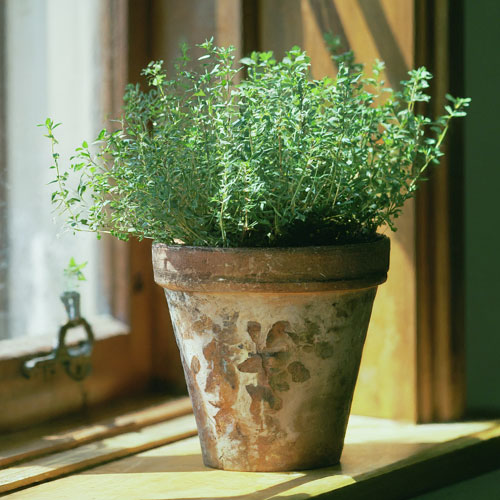
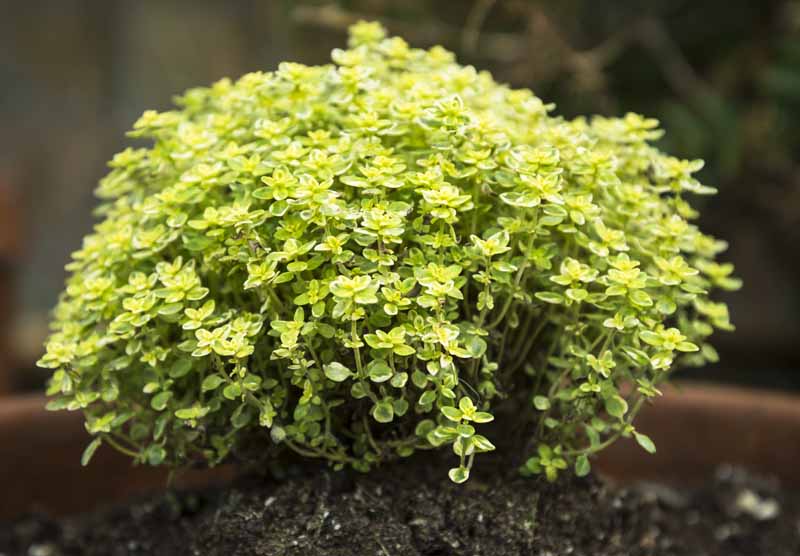
Lemon Thyme (Thymus citriodorus)
For a refreshing twist, lemon thyme offers the same hardy nature as common thyme but with a zesty citrus aroma. Its vibrant flavor makes it a favorite for both cooking and decorative purposes. Lemon thyme grows well indoors, provided it gets ample light.
Creeping Thyme (Thymus serpyllum)
Creeping thyme, known for its trailing growth habit, is ideal for those looking to add an ornamental touch to their indoor garden. While it’s less commonly used in the kitchen, it’s perfect for creating lush greenery in small spaces.
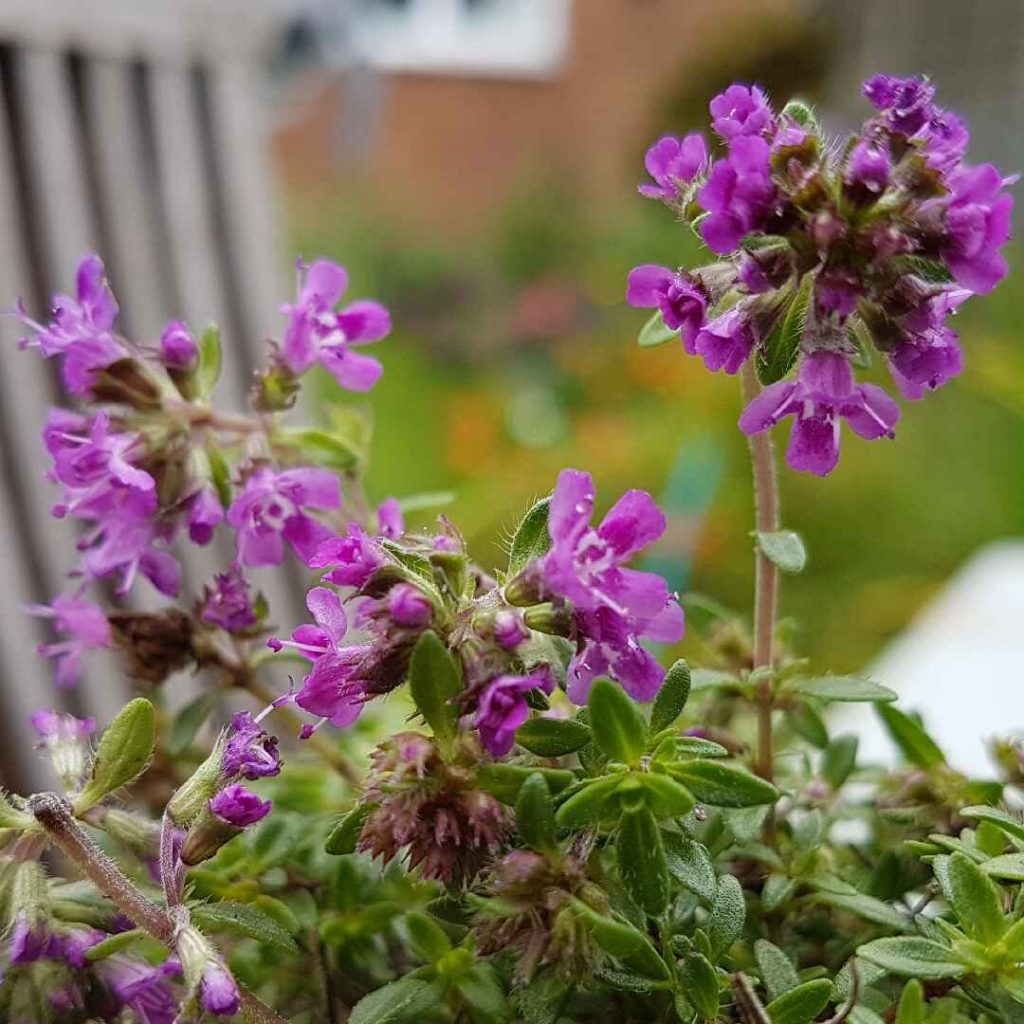
Windy Sprouts’ Tips for Selecting Healthy Plants or Seeds
- Starting from Seeds: Opt for high-quality seeds from reputable suppliers to ensure healthy and vigorous growth. Look for organic, non-GMO seeds whenever possible. Check our article on growing herbs indoors from seeds, we have covered the topic in details.
- Buying Live Plants: If you’re starting with a store-bought plant, inspect it carefully. Healthy thyme plants should have vibrant green leaves and no signs of pests or disease. Avoid plants with yellowing or wilting foliage.
- Propagation from Cuttings: For an eco-friendly and cost-effective approach, propagate thyme from a healthy outdoor plant. Cuttings establish quickly and are well-suited for indoor containers.
Essential Requirements for Growing Thyme Indoors
Growing thyme indoors successfully depends on providing the right conditions that mimic its natural environment. As a hardy Mediterranean herb, thyme thrives in specific settings that cater to its sunlight, soil, and water needs. Here’s a breakdown of everything you need to know to create the perfect environment for your indoor thyme:
Light Needs
Thyme is a sun-loving herb that requires 6–8 hours of bright, direct sunlight daily to grow robustly.
- Natural Light: Place your thyme near a south- or west-facing window where it can bask in the sun.
- Supplemental Light: If natural sunlight is limited, invest in a grow light to provide the necessary intensity. LED grow lights with a full spectrum are particularly effective. Position the light 6–12 inches above the plant and run it for 10–12 hours daily.
Windy Sprouts’ Tip: Rotate the pot every few days to ensure even exposure to light, preventing uneven growth.
Soil
Thyme thrives in well-draining, sandy soil with a slightly alkaline to neutral pH of 6.0–8.0.
- Use a cactus or succulent potting mix, which mimics thyme’s natural growing conditions.
- Alternatively, mix regular potting soil with sand or perlite in a 2:1 ratio for improved drainage.
- Avoid compact, clay-heavy soils that retain water, as thyme’s roots are prone to rot in soggy conditions.
Windy Sprouts’ Tip: Test your soil’s pH with a soil testing kit. If the pH is too acidic, mix in a small amount of agricultural lime to balance it.
Container Selection
Choosing the right pot is crucial for thyme’s health.
- Use pots with drainage holes to prevent waterlogging, which can lead to root rot.
- Terracotta pots are an excellent choice as they allow excess moisture to evaporate and promote better airflow to the roots.
- Ensure the pot size is proportional to the plant; a 6–8 inch pot is ideal for most thyme varieties.
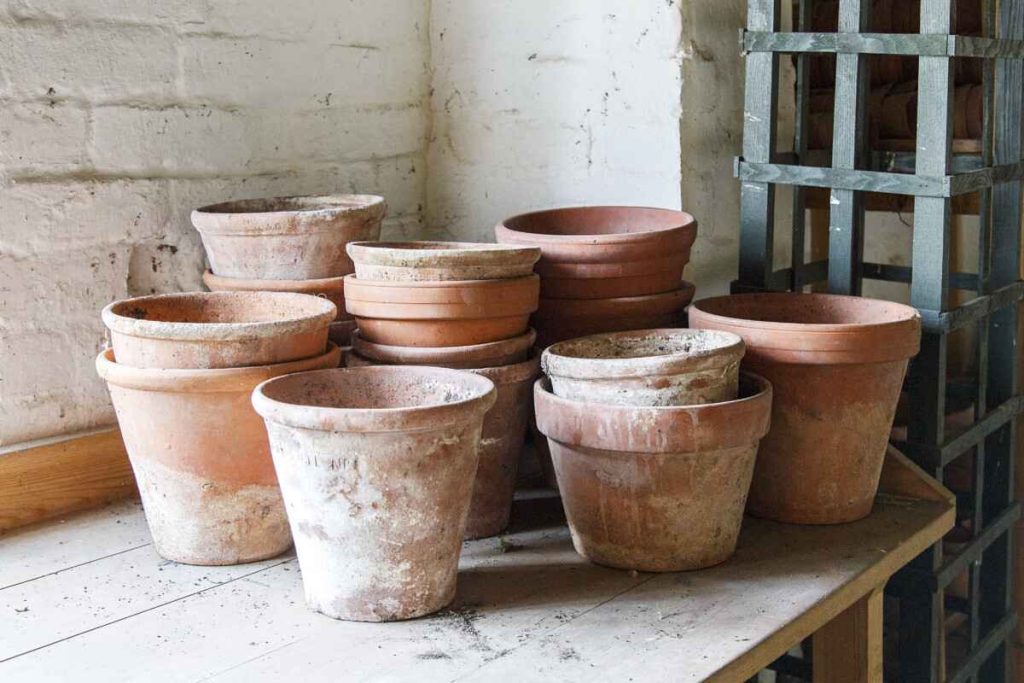
Windy Sprouts’ Tip: Avoid over-potting, as thyme prefers slightly snug spaces that allow its roots to stay anchored.
Temperature and Humidity
Thyme thrives in a warm, low-humidity environment with temperatures between 60–75°F (15–24°C).
- Keep the plant away from cold drafts, such as near open windows in winter or air conditioning vents.
- Avoid placing thyme in overly humid areas like bathrooms or kitchens, as excessive humidity can encourage fungal diseases.
Windy Sprouts’ Tip: If your indoor air tends to be dry, thyme will still thrive, but ensure the surrounding temperature remains stable.
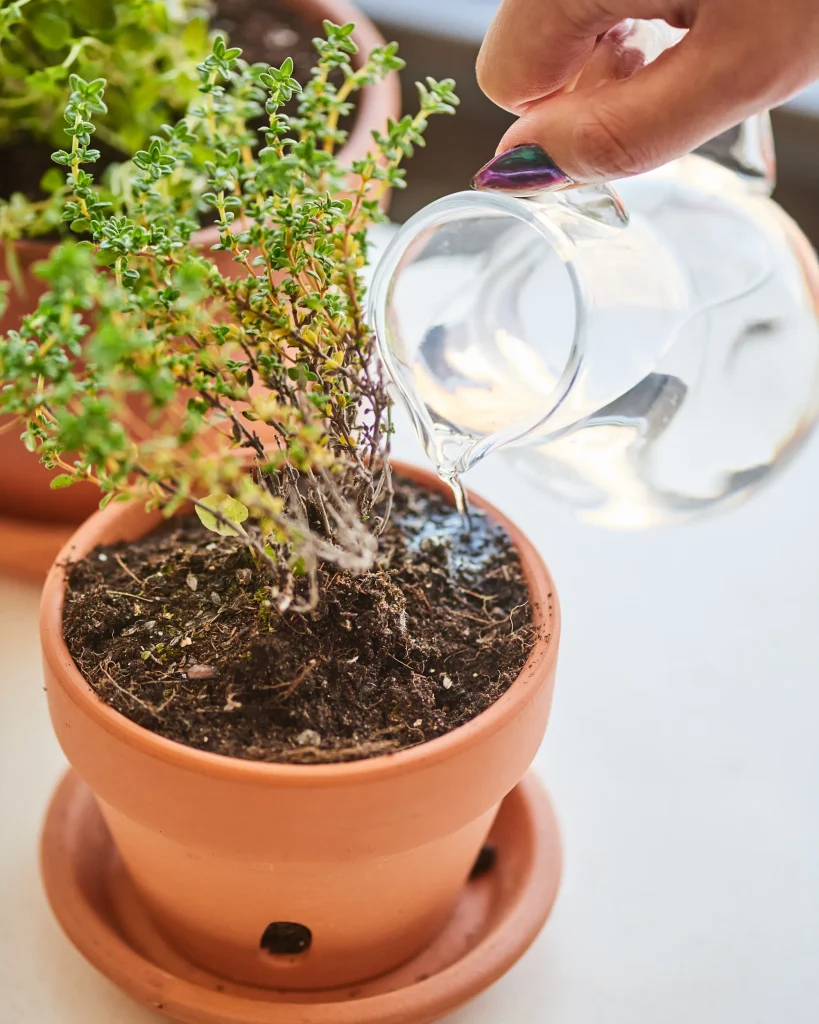
Watering Tips
Proper watering is essential for healthy thyme. This herb prefers slightly dry conditions and is sensitive to overwatering.
- Water only when the top inch of soil feels dry to the touch. Stick your finger into the soil to check before watering.
- Use a watering can with a narrow spout to direct water to the base of the plant, avoiding the leaves.
- Allow excess water to drain completely after each watering.
Windy Sprouts’ Tip: If you’re unsure, err on the side of underwatering—thyme is drought-tolerant and recovers more easily from dryness than overwatering.
Planting Thyme Indoors: Step-by-Step Guide
Planting thyme indoors requires careful planning and execution to ensure optimal growth. Whether you’re starting with seeds, cuttings, or store-bought plants, following the right techniques will give your thyme the best chance to thrive. Here’s an expert guide to help you get started:
Planting Thyme from Seeds
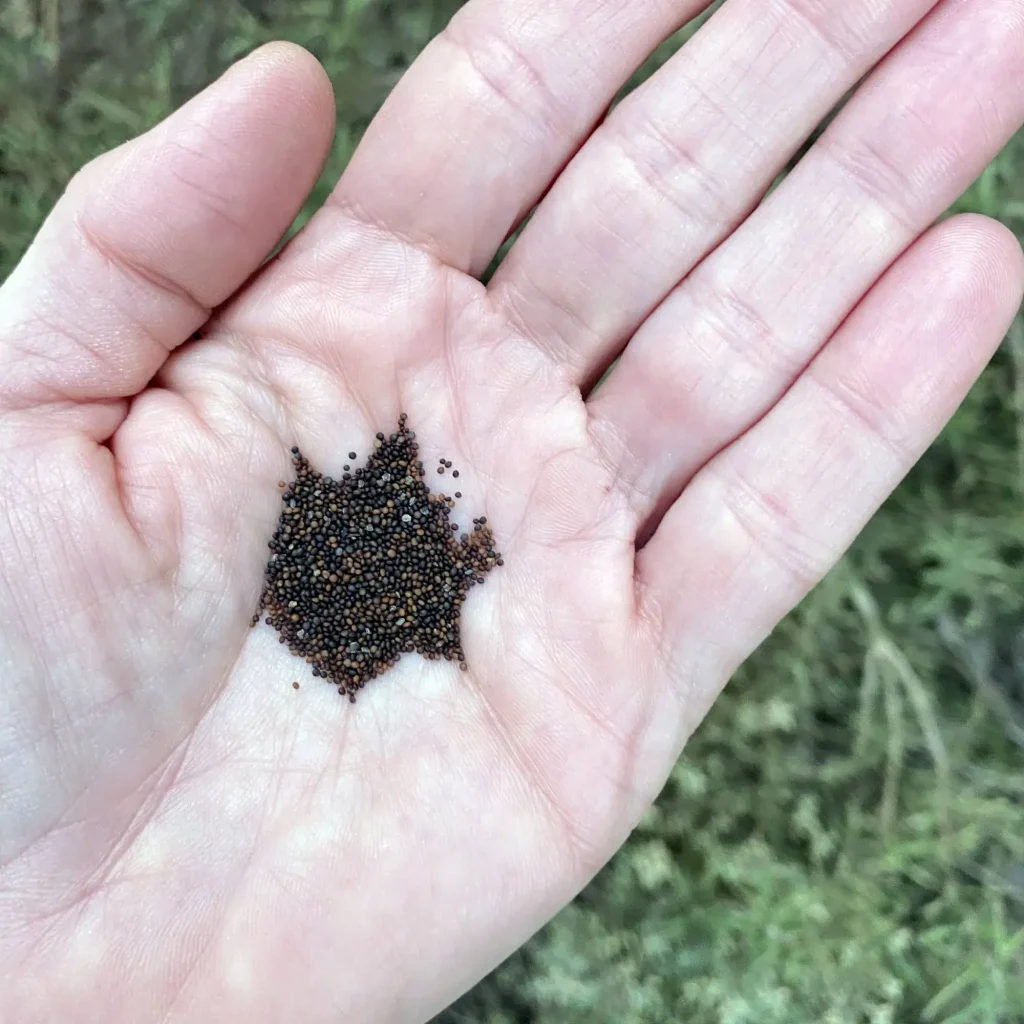
Growing thyme from seeds requires patience, as germination can take 1–4 weeks.
- Prepare the Soil: Fill a seed tray or small pots with well-draining soil, such as a mix of potting soil and sand or perlite. Moisten the soil lightly before planting.
- Sow the Seeds: Sprinkle thyme seeds evenly on the surface of the soil and press them down gently without covering them completely. Thyme seeds need light to germinate.
- Provide Warmth and Light: Place the tray or pots in a warm location with plenty of light, or use a grow light to maintain consistent lighting for 10–12 hours daily.
- Water Carefully: Mist the soil lightly to keep it moist but not waterlogged during germination.
Windy Sprouts’ Tip: Cover the tray or pots with clear plastic wrap to retain humidity, but remove it once seedlings emerge to prevent mold growth.
Planting Thyme from Cuttings
Starting thyme from cuttings is quicker than using seeds and ensures you’re propagating a healthy, mature plant.
- Select Healthy Cuttings: Choose a 4–6 inch cutting from a healthy thyme plant, preferably one without flowers.
- Remove Lower Leaves: Strip the bottom leaves from the cutting, leaving only the top set of leaves.
- Root the Cutting: Place the cutting in a glass of water or directly into moist, well-draining soil. If using water, change it every 2–3 days to keep it fresh.
- Provide Light and Warmth: Place the cutting in a bright location but out of direct sunlight until roots develop (usually within 2–3 weeks).
Windy Sprouts’ Tip: Dip the cut end of the cutting in a rooting hormone before planting to speed up root growth.
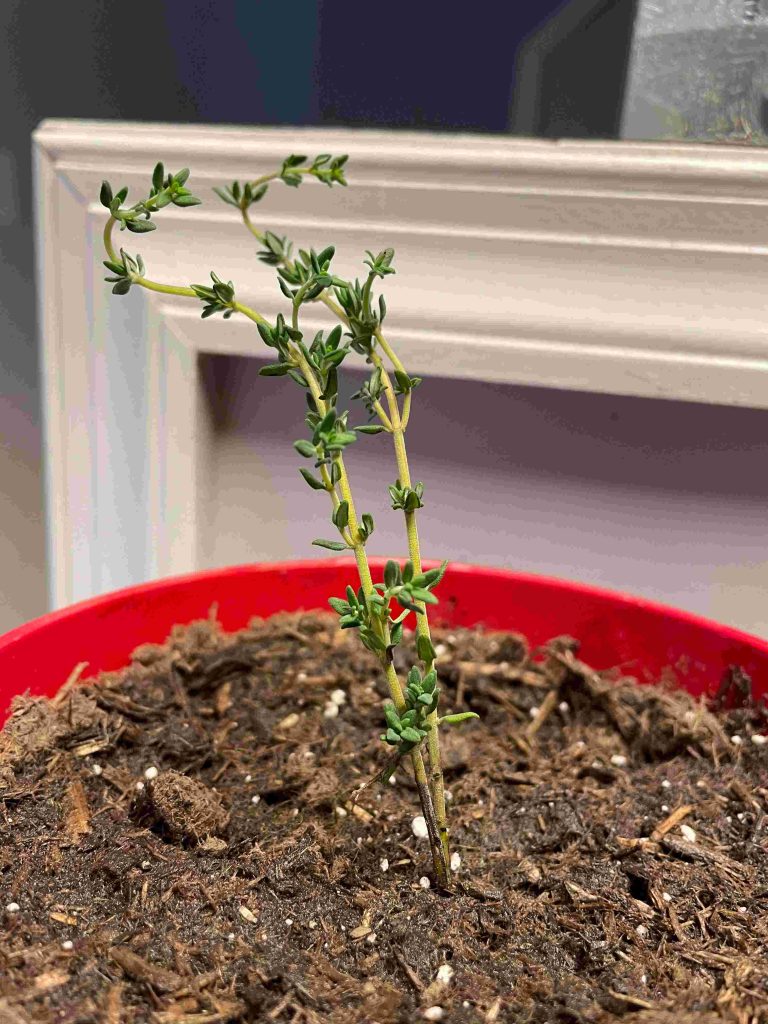
Common Mistakes to Avoid During Planting
- Overcrowding Seeds or Plants: Thyme needs space for air circulation to prevent fungal diseases. Plant seeds or cuttings at least 6–8 inches apart.
- Planting Too Deeply: Thyme’s roots are shallow, so avoid burying the plant too deep in the soil.
- Skipping Drainage: Always use pots with drainage holes to prevent root rot, a common issue for thyme.
By following these planting techniques, you’ll ensure a strong start for your indoor thyme. Whether you’re working with seeds, cuttings, or store-bought plants, providing the right conditions during the planting phase sets the foundation for healthy growth. Up next, learn how to care for your thyme to keep it thriving indoors.
Caring for Thyme Indoors: Practical Maintenance Tips
Once your thyme is planted, proper care is essential to keep it healthy and thriving. Indoor thyme is relatively low-maintenance, but providing the right attention ensures it remains productive and vibrant. Below are expert-approved care tips tailored for indoor thyme:
Watering Thyme Indoors
Thyme is drought-tolerant and prefers slightly dry conditions, so overwatering is one of the most common mistakes to avoid.
- Check the Soil: Water only when the top inch of soil feels dry to the touch.
- How to Water: Use a watering can with a narrow spout to direct water to the base of the plant. Avoid getting the leaves wet, as excess moisture can lead to fungal issues.
- Drainage is Key: Always ensure water drains out completely after watering. Never let the plant sit in standing water.
Windy Sprouts’ Tip: If unsure, it’s better to underwater thyme than overwater. This hardy herb bounces back from dryness but struggles with soggy roots.
Fertilizing Thyme
Thyme doesn’t require heavy feeding, as too much fertilizer can lead to weak, leggy growth.
- Frequency: Feed thyme every 4–6 weeks during the growing season (spring and summer) with a balanced, diluted liquid fertilizer.
- Type of Fertilizer: Use a fertilizer with a lower nitrogen content to maintain compact growth and enhance flavor.
- Avoid Over-Fertilizing: Excess nutrients can dilute thyme’s natural aroma and taste.
Windy Sprouts’ Tip: During the dormant period (fall and winter), skip fertilization to prevent overgrowth and nutrient buildup.
Pruning Thyme
Regular pruning keeps thyme healthy, encourages new growth, and prevents it from becoming woody.
- When to Prune: Trim thyme regularly, especially during the growing season, to keep it bushy and prevent it from flowering.
- How to Prune: Use sharp scissors or pruning shears to snip off about 2–3 inches from the tips. Always leave at least 3–4 inches of stem for regrowth.
- Remove Dead Growth: Check for and cut off any yellowing or dead leaves to keep the plant tidy.
Windy Sprouts’ Tip: Harvest thyme regularly for cooking, as this naturally doubles as pruning and promotes healthier growth.
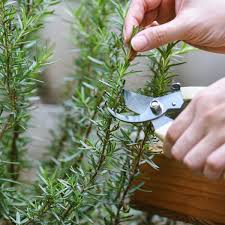
Pest Management
Indoor thyme is less prone to pests, but occasional infestations can occur.
- Common Pests: Watch out for aphids, spider mites, and whiteflies.
- Natural Remedies: Wipe the leaves with a damp cloth or spray with a mixture of water and mild soap to eliminate pests.
- Prevention: Maintain good air circulation around the plant and avoid overwatering, which can attract pests and encourage fungal growth.
Windy Sprouts’ Tip: Inspect your thyme weekly to catch any pest issues early before they spread.
Managing Light and Temperature
Thyme’s growth depends heavily on consistent light and warmth.
- Light: Ensure thyme receives 6–8 hours of bright sunlight daily. If natural light is insufficient, supplement with grow lights.
- Temperature: Keep the plant in a stable environment with temperatures between 60–75°F (15–24°C). Avoid exposure to cold drafts or extreme heat.
Windy Sprouts’ Tip: If you notice your thyme growing leggy, it’s a sign it’s not getting enough light. Move it closer to a sunny window or increase grow light exposure.
With proper watering, pruning, and pest management, your indoor thyme will thrive year-round. By following these care tips, you can ensure a steady supply of fresh, fragrant thyme for your kitchen and enjoy the benefits of a healthy, vibrant indoor herb garden. Up next, explore how to make the most of your thyme harvest!
When to your Harvest Thyme?
Thyme is ready for harvesting once it reaches about 6–8 inches in height, typically after 2–3 months of planting.
- Best Time of Year: You can harvest thyme year-round, but it’s most flavorful just before it begins to flower.
- Frequency: Regular harvesting encourages bushier growth, but avoid overharvesting to keep the plant healthy.
Our Tip: Harvest thyme in the morning, after the dew has dried but before the sun is too intense. This is when the essential oils are at their peak, giving you the most flavorful sprigs.
Common Challenges and Solutions
Even with proper care, growing thyme indoors may come with a few challenges. However, most issues can be resolved with timely intervention and adjustments. Here are some of the most common problems and expert-recommended solutions:
Leggy Growth
- Cause: Inadequate light. Thyme needs plenty of direct sunlight to maintain its compact, bushy shape.
- Solution: Move your plant to a sunnier spot, preferably a south-facing window. If natural light is insufficient, invest in a quality grow light to provide 6–8 hours of consistent light daily.
Our Tip: Rotate the pot weekly to ensure all sides of the plant receive equal light, preventing uneven growth.
Yellowing Leaves
- Cause: Overwatering, which leads to root rot or soggy soil.
- Solution: Adjust your watering schedule. Let the top inch of soil dry out completely before watering again. Ensure the pot has proper drainage to prevent water accumulation.
Our Tip: Use a soil moisture meter to accurately gauge when your thyme needs watering.
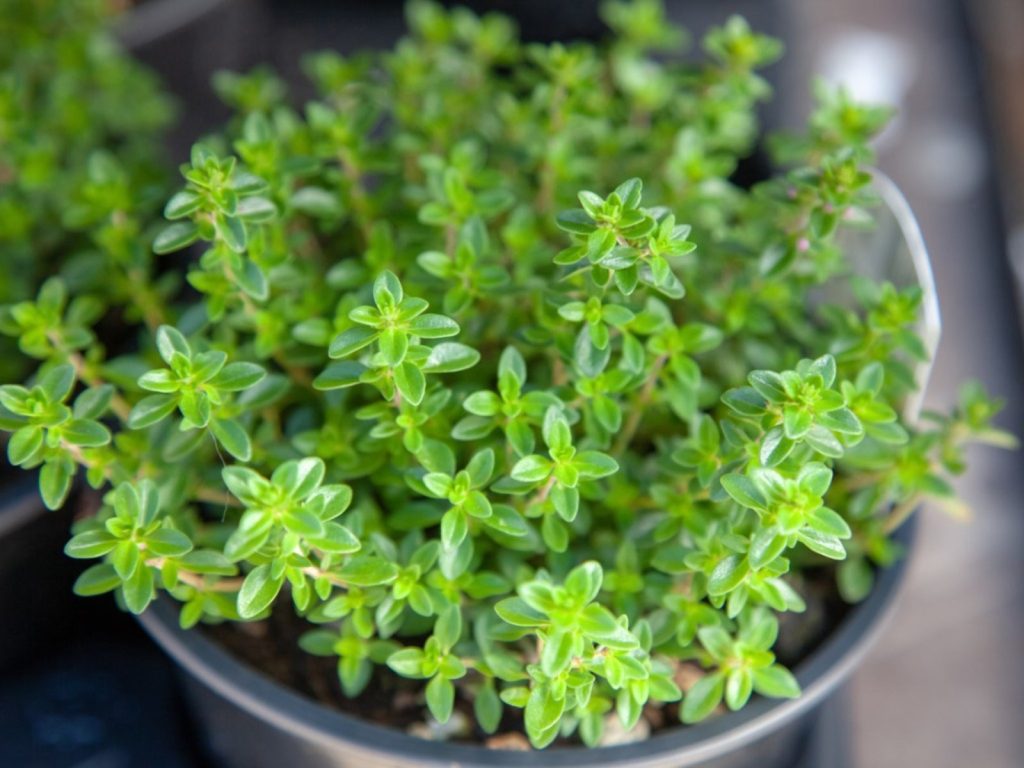
Slow Growth
- Cause: Insufficient nutrients or unsuitable temperatures. Thyme thrives in moderate temperatures (60–75°F) and benefits from occasional feeding.
- Solution: Feed thyme with a balanced, diluted fertilizer every 4–6 weeks during the growing season. Keep it in a temperature-controlled environment, away from cold drafts or excessive heat.
Our Tip: If using grow lights, ensure they don’t generate too much heat, as this can stress the plant.
Final Throughts
Thyme is an exceptional herb for indoor gardening, offering both versatility and ease of care. Whether you’re a seasoned gardener or just beginning your indoor gardening journey, thyme is a perfect choice to bring fresh flavors and greenery into your home.
With the right setup, a little care, and the tips shared in this guide, you can grow thriving thyme plants indoors and enjoy their culinary and medicinal benefits year-round. Don’t let the occasional challenge discourage you—each step brings you closer to becoming a confident and successful indoor gardener.
We’d love to hear about your thyme-growing adventures! Have questions or tips to share? Drop them in the comments below—we’re here to help you every step of the way. Let’s grow together! 🌿
FAQs
Can thyme survive without direct sunlight?
Thyme thrives best with direct sunlight for at least 6–8 hours a day. However, if direct sunlight isn’t available, you can successfully grow thyme using full-spectrum grow lights. Place the grow lights close enough to mimic natural sunlight, and rotate the plant regularly for even growth.
How often should I water indoor thyme?
Indoor thyme prefers slightly dry conditions, so water only when the top inch of soil feels completely dry. Overwatering can lead to root rot and yellowing leaves. Always ensure your pot has proper drainage, and avoid letting the plant sit in standing water.
Can I grow thyme indoors year-round?
Yes! Thyme is a perennial herb and can be grown indoors all year round with proper care. Ensure it receives sufficient light, moderate temperatures, and occasional feeding during the growing season. With the right setup, you can enjoy fresh thyme in any season.
If you have more questions about growing thyme indoors, feel free to ask in the comments—we’re here to help! 🌿

